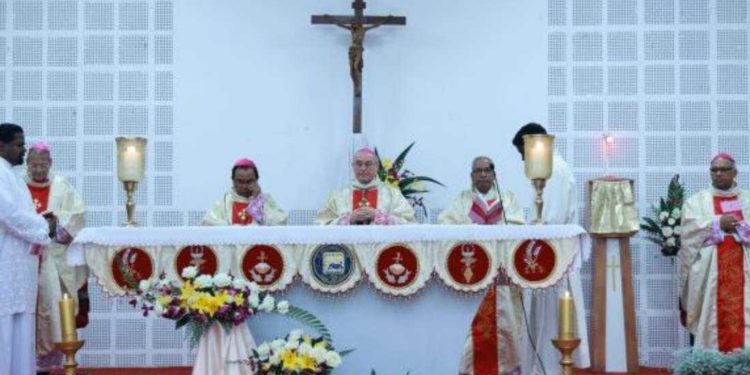Latin rite prelates at their plenary this week have a responsibility to prove meetings are worth more than the money spent
Archbishop Leopoldo Girelli, the apostolic nuncio to India and Nepal, celebrates the Holy Eucharist with other concelebrants on the second day of the 34th Plenary Assembly of the Conference of Catholic Bishops of India (CCBI) in the southern Indian city of Bengaluru on Jan. 25. (Photo: CCBI website)
In recent years, the simple church-going Catholics in India, the world’s biggest democracy, have been scandalized by allegations of clerical sex abuse and financial crimes rocking the Catholic Church in India. Will that be a botheration for the bishops as they gather for their annual plenary meeting this week in southern Indian Bangalore city?
The growing rift and spirited fight among the bishops, priests, and the laity, some of them involving court cases, have undermined Catholics’ faith in the Church’s self-stabilizing system and exposed to the world the serious lack of leadership in the Indian Catholic Church today.
Mainstream national media have run headlines of sex scandals, financial misappropriation, and land scandals involving priests and bishops. Court cases continue about a bishop accused of raping a nun, and a cardinal accused of alienating Church lands. But both continue in office.


Gone are the days when people in general and Catholics in particular, believed that bishops and priests could do no wrong. They were seen as representatives of Christ on earth. The crimes and credible allegations have helped Catholics to recognize the clerics’ humble human existence and weaknesses with sympathy.
“Catholics now begin to wonder if some Indian clerics have developed an unholy alliance with some Vatican bureaucrats to cover up their crimes”
In the past, Catholics believed if a priest committed a crime, the Catholic system would efficiently and swiftly act to rectify the situation, independent of the civil system. They had faith in the Church’s internal self-curing system. But that faith has been shattered by official inaction in the face of a series of recent scandals in India.
In the past few months, a senior Catholic priest in western India, who held important ministry, was arrested and sent to jail, and a theologian-bishop has been accused of abetting a sex crime. The bishop sought and received anticipatory bail to prevent his arrest, but the court asked him to report to the police twice a week until the charges were laid against him and filed before the court. An archbishop in southern India sought police protection to celebrate the holy Mass because he fears attacks from Catholics. What is really going on?
Some bewildered Catholics now begin to wonder if some Indian clerics have developed an unholy alliance with some Vatican bureaucrats to cover up their crimes and to protect their seats of power. But all sections of the Church — bishops and the priests, religious and laity — agree that nobody is in control of the tumultuous hierarchs in the Indian Church.
The Catholic Bishops Conference of India (CBCI), the canonical body comprising of the bishops of Latin, Syro-Malabar, and Syro-Malankara rites, continues to be a mute spectator of skirmishes and the unholy battles as it has no canonical authority to act on a bishop or diocese. Canonically each bishop is independent — with legislative, administrative and judicial powers concentrated on him — to run the diocese. Each bishop is accountable only to the pope.
The Indian Catholic Church is not a reality but continues to be an unrealized idea. What exists, in reality, are three independent Churches of three rites. The two oriental rites have synods empowered to manage their affairs, including choosing bishops and appointing them with papal approval. The Latin rite has an independent conference, which, just like the other larger conference, has no canonical powers to interfere in the administration of a diocese.
The group having an annual plenary this week in Bangalore is the Latin rite bishops’ forum, called the Conference of Catholic Bishops of India (CCBI). The week-long 34th plenary of some 130 bishops is scheduled to conclude on Jan. 30.
What do so many bishops do for a whole week? As a practice, they will have a theme around which experts — mostly priest-theologians and sociologists — will present papers. They will also talk about current socio-political situations, issues and trends in the Church.
“The bishops’ conference meeting should not be reduced to an annual club meeting”
The bishops will make no decision to be implemented in any diocese because they have no powers to do so. They usually issue a statement, often a set of resolutions, promising to act on certain issues such as the environment or human rights. Most often the resolutions are cast in such a way that the onus of implementing them falls on the laity, priest, and religious. The bishops are largely free from their own resolutions!
Such annual meetings are important as they help the bishops come together and update themselves about happenings and trends in the culturally divergent regional Churches of India. It also helps them share pastoral problems and practical solutions in different cultures and situations.
Do these meetings help Catholics in any way, particularly when the body of the Church is bleeding because of clerical abuses and crimes? Do bishops sincerely try to address the issues facing the Church? If the outcome of past meetings is any indication, the answer is negative.
If their conference has no canonical authority to address issues bothering them and their people, it is imperative that they press for changes in the laws and systems of the Church to help national bodies act with authority. After all, the bishops’ conference meeting should not be reduced to an annual club meeting.
Each week-long annual meeting of bishops comes at an estimated expense of US$35,000 — for accommodation, food and travel alone — which is money taken from the donations and incomes of the dioceses. It is huge money considering the poverty of Catholics in several Indian dioceses. The bishops have a responsibility to prove their meetings are worth more than the money spent.
India’s 19 million Catholics have a right to know about their leaders’ plans to address the problems created by bishops and priests, which have sullied the face of the Church. If the bishops are serious about the synodal Church, they ought to be serious about their meetings.
Michael Gonsalves, based in western Indian Pune city, has over 30 years of experience reporting and editing for mainstream national newspapers and teaching journalism. With a doctorate in journalism, Gonsalves is now an independent freelance journalist and writes about business, religion and society. The views expressed in this article are those of the author and do not necessarily reflect the official editorial position of UCA News.
Latest News
Credit: Source link




